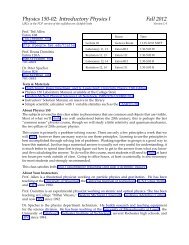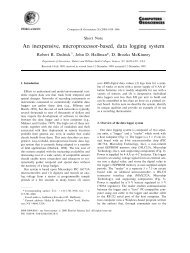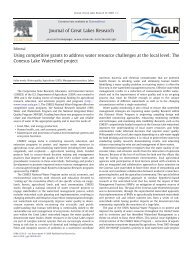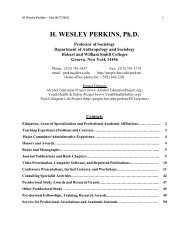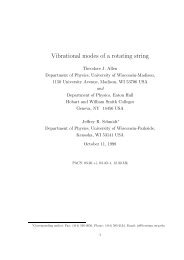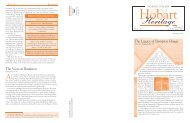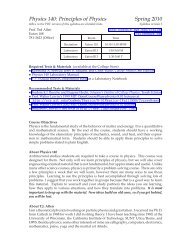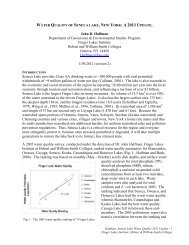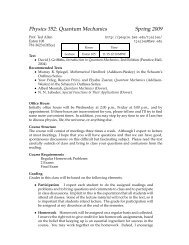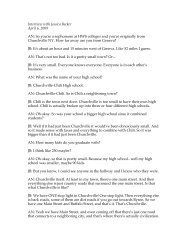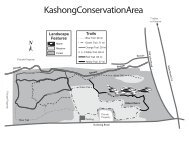Geology of New Zealand Field Trip Guidebook - ResearchGate
Geology of New Zealand Field Trip Guidebook - ResearchGate
Geology of New Zealand Field Trip Guidebook - ResearchGate
Create successful ePaper yourself
Turn your PDF publications into a flip-book with our unique Google optimized e-Paper software.
it, the melt water stream emerging from the snout, the character <strong>of</strong> the outwash sediments,<br />
striations on the overhanging valley walls, and evidence <strong>of</strong> higher stands <strong>of</strong> the glacial ice,<br />
especially lateral moraines. If the weather is good, you may be able to look up the glacier to<br />
see the snow fields below Aoraki. Both Fox and Franz Josef glaciers extend down nearly to<br />
sea level, while the glaciers on the east side <strong>of</strong> the Southern Alps are confined to high<br />
elevations (recall the hike up to Hooker Glacier). While the temperatures on both sides <strong>of</strong> the<br />
Alps are similar, precipitation patterns are not. The extension <strong>of</strong> west coast glaciers to lower<br />
elevations reflects not cooler temperatures, but the greater supplies <strong>of</strong> winter snow delivered<br />
to the western slopes. Recall the glacial budget we discussed in lecture. In what other ways<br />
can you compare and contrast the Hooker and Fox glaciers?<br />
Notebook Assignment: Make the observations mentioned above and describe them in your<br />
notebook. Any other observations will garner higher marks.<br />
Stop 4: Hare Mare Creek, Alpine Fault Exposure<br />
The Alpine Fault is exposed 200 m up the creek in the south bank. We will walk up the north<br />
bank to view the fault. Beanland [, 1987 #3] describes the exposure as mylonite thrust over<br />
gravel. Mylonite is a fine-grained metamorphic rock that commonly has very fine banding <strong>of</strong><br />
different colors. Mylonite only occurs in shear zones like the Alpine Fault, where<br />
tremendous amounts <strong>of</strong> stress are placed on the rocks right around the fault. This stress<br />
causes minerals to reform and align in bands to essentially take up less space.<br />
Notebook Assignment: Sketch this exposure, indicating the features that mark it as a fault<br />
zone. This is about as close as you can get to seeing a boundary between two plates. Do you<br />
notice any difference in the rocks on either side <strong>of</strong> the fault? As you consider the fault and<br />
the transform boundary it represents, remember that there has been more than 450 km <strong>of</strong> slip<br />
along this fault.<br />
Day 5—Tuesday 18 November.<br />
[f\<br />
Stop 1: Franz Josef Visitor Center<br />
Our first stop this morning will be the Franz Josef Visitor Center. Take your notebook and<br />
make some notes on two aspects <strong>of</strong> the local geology: 1) the Alpine Fault and the earthquake<br />
hazards it presents, and 2) the historical record <strong>of</strong> ice advance and retreat for both the Franz<br />
Josef and Fox glaciers. Also, be on the lookout for signs <strong>of</strong> the trace <strong>of</strong> the Alpine Fault. We<br />
will cross it at some point between the Holiday Park and the glacier.<br />
Stop 2: Waiho River Bridge and Franz Josef Glacier Access Road<br />
The Waiho River drains the Franz Josef Glacier (with contributions from other streams) and<br />
is considered a major flood risk by the <strong>New</strong> <strong>Zealand</strong> Ministry <strong>of</strong> Civil Defense and<br />
Emergency Management. Below the canyon mouth (west <strong>of</strong> the highway bridge), the river is<br />
partially constrained by the Waiho Loop, a recessional moraine that forms a prominent<br />
forested ridge. Between the glacier front and this moraine, the riverbed is aggrading<br />
(depositing sediment) with glacially derived sediment. Between 1940 and 2002 the river bed<br />
rose by more than 10 meters, lifting it above adjacent areas and creating significant flood<br />
risks. This risk is heightened by periods <strong>of</strong> glacial outburst—sudden, copious releases <strong>of</strong><br />
water from the glacier margin. As you stand by the river, compare the elevation <strong>of</strong> its bed to<br />
24




